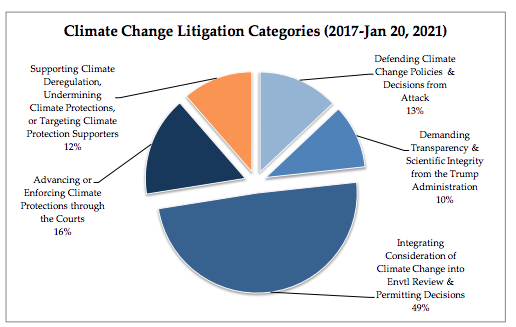By Korey Silverman-Roati
Litigators responded to the Trump administration’s climate deregulation agenda by filing hundreds of lawsuits across the U.S. over the four years of the administration. A new Sabin Center White Paper published today, U.S. Climate Litigation in the Age of Trump: Full Term, takes stock of 378 U.S. climate cases that responded or interacted with federal policy and law during the Trump administration. In the final two years, cases increased, as 219 were filed from 2019 until the end of the term.
“Pro” climate protection cases made up the vast majority of those filed, or 89%. Eleven percent sought to bolster the administration’s climate deregulation efforts, categorized here as “con” cases. Over the last two years of the administration, “pro” cases increased and made up 94% of those filed.
Building off of two previous reports, from year one and year two of the administration, this report categorizes cases into five overarching responses to Trump climate deregulation policy. They are:
- Defending Obama Administration Climate Change Policies & Decisions;
- Demanding Transparency & Scientific Integrity from the Trump Administration;
- Integrating Consideration of Climate Change into Environmental Review & Permitting;
- Advancing or Enforcing Additional Climate Protections through the Courts; and
- Deregulating Climate Change, Undermining Climate Protections, or Targeting Climate Protection Supporters.
The first four categories describe “pro” climate protection claims, where, if successful, the suit would strengthen climate regulation or protection. The fifth and final category includes all “con” cases, where, if successful, the suit would bolster climate deregulation and undermine climate protection. The proportion of cases from each category is shown in Figure 1 below.
In addition to the five main categories above, the report further categorizes the cases according to their (1) plaintiffs, (2) defendants, (3) sector, and (4) laws at issue. Some of the takeaways are described here, with more detail and charts available in the report.

In “pro” climate cases, NGOs were a filing party in the about three fourths of claims, making up 78%, followed by government entities (27%), individuals (9%), and industry (5%). In “con” climate cases industry groups filed the most cases (65%), followed by NGOs (23%), governments (16%), and individuals (14%).
Parties named the federal government as a defendant in the vast majority of claims (84%). Among the agencies sued, parties named the Department of Interior most often (in 35% of cases), followed by the Environmental Protection Agency (17%). Although they made up a lower percentage of the total, suits against the U.S. Army Corps of Engineers, the Department of Commerce, and the Department of Transportation increased in the final two years.
The disputes most commonly invoked federal environmental law (in 66% of cases) and administrative law (in 48% of cases). The final two years of the Trump administration saw notable increases in those invoking federal energy law (8 cases in the first two years, 21 in the final two), and federal environmental law (in 76% of cases in the final two years).
The report includes appendices with case information and links to all 378 cases in the Sabin Center/Arnold & Porter U.S. Climate Change Litigation Database. Further analysis could build on the data to paint an even fuller picture of climate litigation during Trump’s four years in office.
Tiffany is the Communications Associate at the Sabin Center for Climate Change Law.



